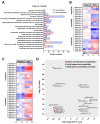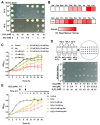Indole Acetic Acid: A Key Metabolite That Protects Marine Sulfitobacter mediterraneus Against Oxidative Stress
- PMID: 40431187
- PMCID: PMC12114110
- DOI: 10.3390/microorganisms13051014
Indole Acetic Acid: A Key Metabolite That Protects Marine Sulfitobacter mediterraneus Against Oxidative Stress
Abstract
For marine bacteria, the phycosphere is attractive as a major source of labile nutrients, but it also presents challenges due to the accumulation of stressors, such as reactive oxygen species (ROS) from algal metabolisms. Therefore, successful colonization of bacteria in the phycosphere requires an efficient mechanism to fight against oxidative stress, which is still a missing piece in studying bacteria-algae interactions. Here, we demonstrate that a common metabolite, indole acetic acid (IAA), enables the Roseobacter clade Sulfitobacter mediterraneus SC1-11, an IAA-producer, to resist hydrogen peroxide (H2O2) stress and that IAA biosynthesis can be activated by low concentrations of H2O2. Proteomics and metabolomics analyses revealed that bacteria consume high amino acid levels when exposed to H2O2 stress, while exogenous supplementation with IAA effectively protects bacteria from ROS damage and alleviates amino acid starvation by upregulating several proteins responsible for replication, recombination, and repair, as well as two proteins involved in amino acid transport and metabolism. Furthermore, the supplementation of some amino acids, such as arginine, also showed a significant protective effect on bacteria under H2O2 stress. This study highlights an unprecedented role of IAA in regulating amino acid metabolisms for resisting oxidative stress, which may be a specific strategy for adapting to the phycosphere.
Keywords: Sulfitobacter mediterraneus; amino acid metabolism; bacterial–algal interaction; indole acetic acid; marine microbiome; oxidative stress.
Conflict of interest statement
The authors declare no conflict of interest.
Figures





Similar articles
-
Indole-3-acetic acid as a cross-talking molecule in algal-bacterial interactions and a potential driving force in algal bloom formation.Front Microbiol. 2023 Oct 20;14:1236925. doi: 10.3389/fmicb.2023.1236925. eCollection 2023. Front Microbiol. 2023. PMID: 37928680 Free PMC article. Review.
-
Indole-3-acetic acid (IAA) protects Azospirillum brasilense from indole-induced stress.Appl Environ Microbiol. 2025 Apr 23;91(4):e0238424. doi: 10.1128/aem.02384-24. Epub 2025 Mar 25. Appl Environ Microbiol. 2025. PMID: 40130845 Free PMC article.
-
Indole-3-Acetic Acid Alleviates Nonalcoholic Fatty Liver Disease in Mice via Attenuation of Hepatic Lipogenesis, and Oxidative and Inflammatory Stress.Nutrients. 2019 Sep 3;11(9):2062. doi: 10.3390/nu11092062. Nutrients. 2019. PMID: 31484323 Free PMC article.
-
The Protective Effect of Indole-3-Acetic Acid (IAA) on H2O2-Damaged Human Dental Pulp Stem Cells Is Mediated by the AKT Pathway and Involves Increased Expression of the Transcription Factor Nuclear Factor-Erythroid 2-Related Factor 2 (Nrf2) and Its Downstream Target Heme Oxygenase 1 (HO-1).Oxid Med Cell Longev. 2017;2017:8639485. doi: 10.1155/2017/8639485. Epub 2017 Jun 14. Oxid Med Cell Longev. 2017. PMID: 28694916 Free PMC article.
-
Indole-3-acetic acid biosynthesis and its regulation in plant-associated bacteria.Appl Microbiol Biotechnol. 2020 Oct;104(20):8607-8619. doi: 10.1007/s00253-020-10869-5. Epub 2020 Sep 2. Appl Microbiol Biotechnol. 2020. PMID: 32875364 Review.
Cited by
-
Identification of Bioactive Peptides from Caenorhabditis elegans Secretions That Promote Indole-3-Acetic Acid Production in Arthrobacter pascens ZZ21.Microorganisms. 2025 Aug 21;13(8):1951. doi: 10.3390/microorganisms13081951. Microorganisms. 2025. PMID: 40871455 Free PMC article.
References
-
- Astafyeva Y., Gurschke M., Qi M., Bergmann L., Indenbirken D., De Grahl I., Katzowitsch E., Reumann S., Hanelt D., Alawi M., et al. Microalgae and bacteria interaction—Evidence for division of Diligence in the alga microbiota. Microbiol. Spectr. 2022;10:e00633-22. doi: 10.1128/spectrum.00633-22. - DOI - PMC - PubMed
Grants and funding
LinkOut - more resources
Full Text Sources
Miscellaneous

